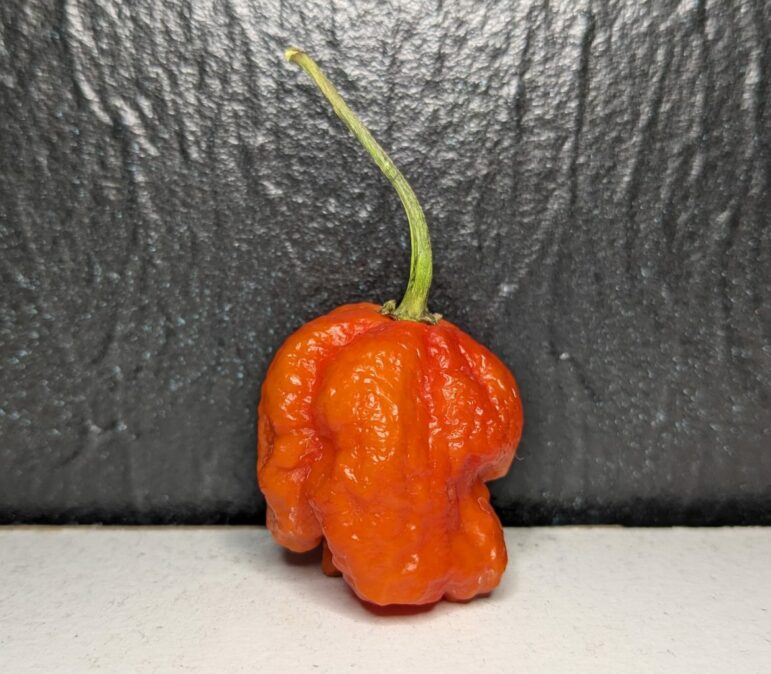
Daniel Schoenherr
Howell pepper grower Ryan Karcher grows Friar’s Fury chilis in pots in his backyard.By DANIEL SCHOENHERR
Capital News Service
LANSING – Guinness World Records recently announced that the world’s new hottest pepper is a veggie known as Pepper X, grown in South Carolina.
But Ryan Karcher, a veteran pepper grower from Howell, questions Pepper X’s reported heat measurement. And he says he has developed a pepper that’s tastier and more representative of the pepper community.
It will be featured in a Jan. 22 television show called Superhot: The Spicy World of Pepper People.
Karcher said he has doubted that Pepper X was truly the world’s hottest since its announcement on Oct. 16, 2023.
“Guinness World Records is a wonderful children’s book,” he said. “It’s not a scientific journal.”
And an expert chemical analyst concludes the pepper was improperly tested after a review of the lab report that Guinness used to verify its heat.
Counters Puckerbutt Pepper Co. president Ed Currie: “I think the pepper-growing community is full of a lot of people who dislike me. It’s already been through the process. I don’t need to prove myself to anybody on social media.”
Pepper spiciness is measured in Scoville heat units. It is based on the concentration of capsaicin and similar compounds that put the heat into peppers.
An average jalapeno pepper has a heat level of about 5,000 Scovilles. But Pepper X’s heat, measured by Winthrop University in South Carolina, averaged nearly 2.7 million Scovilles, as reported by the BBC.
That beats Currie’s previous record for the Carolina Reaper which averages 1.6 million Scovilles.
A lab report on Pepper X’s heat rating that Great Lakes Echo obtained from Winthrop University analytical chemistry professor Clifton Calloway shows that three samples of Pepper X were tested. Two registered just below 2.2 million Scovilles and one registered nearly 2.7 million, according to the report.
Great Lakes Echo asked analytical chemist Geoffery Yeh to independently review the report.
There were multiple errors in the method used to test Pepper X, said Yeh, who has more than 25 years of experience in agricultural chemistry and has tested peppers while studying at the University of California, Davis.
Problems with the calibration of the testing device could mean that Pepper X is milder or hotter than reported, Yeh said.
Calloway acknowledged one change from the Association of Official Analytical Chemists’ capsaicin extraction procedure to account for the small sample size. But Yeh said other deviations could have led to inaccurate results.
“The data indicate that this was not a properly performed calibration and, therefore, you cannot make measurements with it,” Yeh said. “I believe what probably happened is the samples were prepared incorrectly. There’s a variety of ways that you could mess that up.”
Yeh said he found no published studies from Calloway involving pepper testing.
“The instrument that they use is not typically used for this kind of analysis,” he said. “It’s used for looking at metals and stuff, which is what their lab actually does.”
But Calloway said his lab regularly tests peppers to give the university’s chemistry students the chance to gain experience with analysis.
“If anybody wants to bring peppers by, I’d run through their Scoville heat units,” he said. “People contact me to do the same thing, and I’m not going to charge them. I’m just going to get my students to work on it.”
His students use the same testing system for multiple purposes, he said.
“They can make the jump quickly from agricultural samples to environmental samples to biomedical samples, you name it,” he said. “It’s the same system.”
In an email, Calloway explained the inconsistencies Yeh found in the calibration, but Yeh said many were “insufficiently addressed.”
“Guinness will do their thing, their way,” Calloway said in the email.
Yeh said he doubts the data were intentionally manipulated but said Guinness World Records shouldn’t have accepted the results as proof that Pepper X is the world’s hottest.
“The Guinness book is all about measuring things, right? And they didn’t see these problems with measurements here,” he said. “But the devil’s in the details, and there’s some serious problems.”
A requirement to verify the pepper’s record is independent third party testing, Guinness World Records public relations executive Kylie Galloway wrote in an email.
“We provide the applicant with guidelines that are specific to that record category and must be adhered to in order to qualify,” she said. “It is necessary these guidelines are followed to uphold the integrity, accuracy and authenticity of each record title.”
Karcher, the Howell pepper breeder, has created over a thousand varieties over the past 20 years. Creating something as spicy as what was reported for Pepper X “just isn’t possible,” he said.
“I know exactly what to cross to get to 2.2 million (Scoville heat units). I have over 1,800 varieties,” he said. “And I’m not going to come anywhere close to 2.6 million.”
An indication that Pepper X may not be as hot as reported is its mustard color, he said. Mustard-colored pepper pods cannot contain as much capsaicin as the hottest red, orange and chocolate-colored pods.
But Currie insists that Pepper X has proven to be hot stuff.
“I’ve got all the proof I need, and all the people who need to see it have seen it already,” Currie said, “and I’ve had the Guinness World Record before this, too.”
Pepper X has been tested by other universities besides Winthrop, he said, but didn’t identify those labs.
He declined further comment: “If this is going to be a story about both sides of this, disregard my comments,” he said.
Karcher said he won’t believe Pepper X is as hot as Currie claims until it’s released to the public for third-party testing.
“I will give Ed Currie all the credit in the world if he releases that pepper to the general public,” he said. “There is not a single one of us that actually grows and does breeding that believes for one second that pepper hits over 1.5.”
The Associated Press reported that Currie said Pepper X or its seeds wouldn’t be released to the public due to previous problems concerning the Carolina Reaper. Sauces made using the pepper are available online.
In 2019, Karcher started Michigan Chili Grower LLC, an online marketplace to sell sauces and seeds from his peppers.
His hometown namesake pepper, the Howeller, is one of his proudest creations, he said. It wasn’t designed with record-breaking heat in mind, but he said it has an amazing flavor.
Karcher said the Howeller is pretty hot but he can’t discuss the exact heat measurement due to a non-disclosure agreement tied to his role in Superhot: The Spicy World of Pepper People.
“As we move into the new year. Howell, Michigan, (and) the really cool stuff happening in my little hobby garden is going to be known nationwide,” Karcher said.
Karcher said he’s excited about the future of his work.
“It turned into something bigger than I had anticipated,” Karcher said. “And now here I am, you know? I got people from Hollywood reaching out to me to be on television shows.”
Johnny Scoville, the creator of a pepper-tasting YouTube channel called Chase the Heat, agrees that Michigan will soon be known for its peppers.
Scoville goes by the name of the heat rating to boast his tolerance for hot peppers. He declined to reveal his real name to maintain privacy from his 133,000 followers.
Scoville is a “pillar” of the pepper growing community, Karcher said, and has posted about his experience eating peppers nearly every day for the past seven years.
“I’ve eaten thousands of peppers on video,” Scoville said, adding that he hasn’t even “scratched the surface” when it comes to experiencing the taste of every pepper variety.
Scoville said Karcher’s appearance on Superhot will show the world the amazing pepper breeding he’s doing in Howell.
“He makes crosses that other people wouldn’t even think of,” he said. “Before I saw him do that, I thought it was like mating a giraffe with a bull.”
And he shares Karcher’s doubts about Pepper X.
Pepper X is the “Bigfoot” of the pepper world because Currie announced that Pepper X would never be seen by the public, he said.
Scoville hasn’t had the opportunity to try Pepper X.
“I’ve been around for long enough that when any pepper grower gets something piping hot, I’m the first one they reach out to,” he said, “because they know I’ll give them the straight dope about it.”
Of the peppers that Scoville has eaten, he said he’s never had a mustard-colored pepper that is hotter than a chocolate-colored or a red-colored pepper.
“Mustard pods – they just don’t get that hot,” he said. “As the color drains from the pepper, so does the heat.”
Scoville said that Currie brought his pepper’s doubts onto himself by not releasing it to the public.
“He would do himself a favor, he would do the chili world a favor, he would take a lot of heat off his back and he would ultimately sell so much more if he just released that pepper,” he said.
Daniel Schoenherr writes for Great Lakes Echo.

Daniel Schoenherr
The orange coloring of Friar’s Fury, created by Howell pepper grower Ryan Karcher, indicates a high maximum heat level.